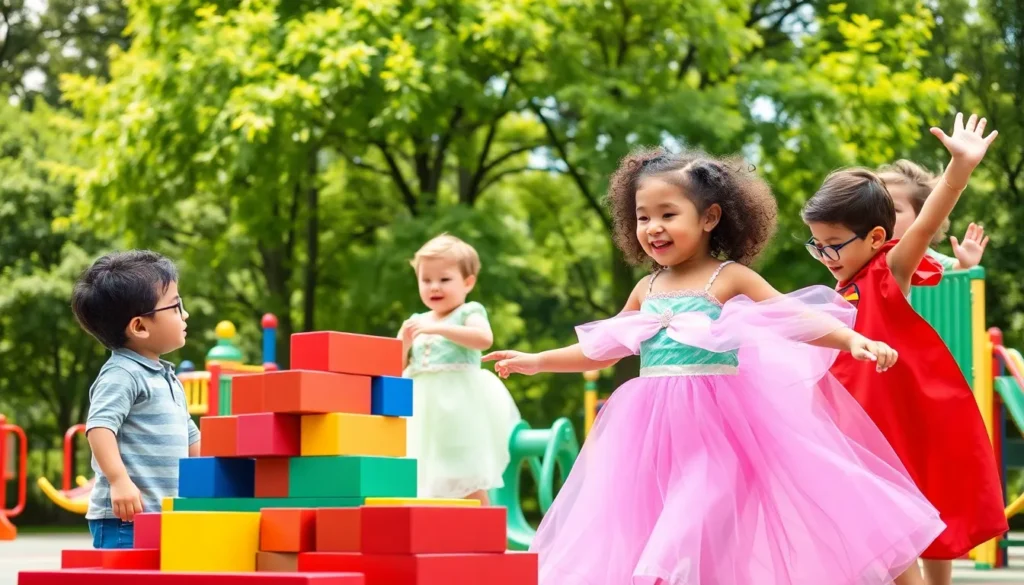Creative play is more than just fun; it’s a vital part of childhood development. Through imaginative games and activities, children explore their world, express emotions, and build critical thinking skills. Engaging in creative play fosters not only social connections but also enhances cognitive abilities, making it essential for holistic growth.
As kids dive into their imaginative realms, they learn to solve problems and collaborate with others. Whether they’re building a fort out of blankets or pretending to be superheroes, these playful experiences lay the groundwork for lifelong skills. Understanding the importance of creative play can help parents and educators nurture a child’s potential, ensuring they thrive in a rapidly changing world.
Table of Contents
ToggleWhat Is Creative Play?
Creative play refers to activities that stimulate imagination and encourage children to express themselves freely. Children engage in creative play through various forms, including art, storytelling, music, and role-playing. Such activities provide opportunities for exploration, allowing them to experiment with different ideas and materials.
Creative play often involves:
- Imagination: Children visualize scenarios, invent characters, and create unique stories.
- Problem-solving: Engaging in creative play enables children to identify challenges and explore multiple solutions.
- Collaboration: Many creative activities involve teamwork, helping children learn to communicate and share ideas effectively.
- Emotional expression: Creative play offers a safe space for children to express feelings and process experiences.
Research indicates that creative play significantly enhances cognitive and social skills essential for overall development. It plays a crucial role in nurturing a child’s curiosity and adaptability, which are vital traits for success in an ever-changing environment.
Benefits of Creative Play

Creative play provides essential benefits for children, significantly influencing their cognitive, emotional, and social development. Engaging in imaginative activities lays the groundwork for critical lifelong skills.
Cognitive Development
Creative play stimulates cognitive abilities. It encourages problem-solving, critical thinking, and decision-making. Activities such as building with blocks or engaging in imaginative storytelling prompt children to explore different scenarios, enhancing their reasoning skills. Research shows that children who participate in creative play exhibit improved memory retention and greater ability to adapt to new situations.
Emotional Growth
Creative play fosters emotional development. It allows children to express feelings in a safe environment, enabling them to process complex emotions. Through role-playing, for instance, children can explore various emotions, learning empathy and self-regulation. Studies indicate that such expression through creative outlets improves emotional resilience, helping children cope with stress and anxiety.
Social Skills Enhancement
Creative play enhances social skills by promoting collaboration and communication. Engaging in group activities encourages children to share ideas, negotiate roles, and resolve conflicts. These interactions develop essential skills such as teamwork and leadership. According to research, children who frequently engage in collaborative creative play exhibit stronger social competence and improved peer relationships.
Types of Creative Play
Creative play encompasses various types, each contributing uniquely to a child’s development. These types include imaginative, artistic, and physical play.
Imaginative Play
Imaginative play, also known as pretend play, allows children to create scenarios using their imagination. They often engage in role-playing activities, taking on different characters in diverse settings. This type of play encourages creativity and storytelling, enabling children to explore social roles and perspectives. Examples include playing house, pretending to be superheroes, or enacting scenes from their favorite stories. Engaging in imaginative play helps enhance problem-solving skills and strengthens emotional intelligence by allowing children to navigate various social situations.
Artistic Play
Artistic play involves creative expression through visual arts such as drawing, painting, and crafting. This type empowers children to convey thoughts and feelings through their artwork, promoting self-expression. It includes activities like using clay to sculpt, coloring with crayons, or making collages from magazines. Artistic play improves fine motor skills and hand-eye coordination while also fostering critical thinking and decision-making as children choose colors, shapes, and materials. Additionally, it nurtures cognitive development by encouraging children to experiment and innovate with different artistic techniques.
Physical Play
Physical play focuses on movement and physical activity, incorporating games and sports that engage children’s bodies. This type of play includes running, jumping, climbing, and playing organized sports. Activities such as tag, obstacle courses, or dance contribute to physical health and motor skill development. Physical play enhances coordination, balance, and strength while also promoting teamwork and cooperation during group activities. Engaging in physical play supports social interaction and emotional regulation by allowing children to express emotions and manage challenges in an active environment.
How to Encourage Creative Play
Encouraging creative play fosters a child’s imagination and enhances their development. Implementing effective strategies can significantly boost children’s engagement and growth during these activities.
Creating a Safe Space
Creating a safe space allows children to explore freely without fear of judgment or failure. Designate a specific area where children can express themselves openly. Ensure the environment is child-proofed and stocked with age-appropriate materials. Include soft furnishings, open floor space, and various textures to stimulate sensory experiences. Allow for flexibility in the space to accommodate different types of creative play. Encourage open-ended activities that promote exploration and curiosity. Support emotional safety by being present, validating feelings, and allowing for mistakes as part of the learning process.
Providing Resources and Tools
Providing resources and tools enhances the creative play experience. Stock up on diverse materials, including art supplies, building blocks, costumes for role-playing, and musical instruments. Encourage experimentation by introducing unconventional items, like recycled materials, to inspire creativity. Offer books and storytelling prompts to stimulate imaginative scenarios. Facilitate access to outdoor areas for physical play, allowing children to engage with nature. Regularly rotate resources to maintain interest and surprise. Support cooperative play by providing resources that encourage collaboration, such as group games or shared projects, fostering social connections and teamwork skills.
Challenges to Creative Play
Creative play faces several challenges that can hinder a child’s imaginative development and overall growth. Two significant obstacles include over-structured environments and excessive screen time.
Over-Structured Environments
Over-structured environments limit children’s opportunities for creative play. These settings often impose strict schedules, pre-determined activities, and rigid outcomes. Children thrive in environments that allow freedom and flexibility. When they have the autonomy to explore and invent, their creativity flourishes. Structured activities can stifle imagination and reduce spontaneous play, making it critical to provide unstructured time for open-ended exploration. Research shows that children benefit from play experiences that prioritize choice and encourage self-directed learning, leading to enhanced creative thinking and problem-solving skills.
Screen Time Impact
Excessive screen time negatively impacts creative play by reducing opportunities for active engagement and imaginative exploration. Many children now spend several hours daily on screens, leading to diminished face-to-face interactions and physical activity. Studies indicate that increased screen time correlates with reduced creative expression and social skills. Active, hands-on experiences foster creativity and cognitive abilities, whereas passive screen consumption limits imaginative play. Balancing screen time with interactive, physical activities encourages creativity and supports healthy development. Developing guidelines for screen use and promoting alternative play options can mitigate these challenges, ensuring children maintain a healthy relationship with technology while engaging in creative activities.
Creative play is essential for nurturing well-rounded children. It fosters critical skills that contribute to cognitive emotional and social development. By engaging in imaginative activities children not only learn to express themselves but also develop problem-solving abilities that will serve them throughout life.
Parents and educators play a crucial role in facilitating creative play by providing the right environment and resources. Encouraging exploration and collaboration allows children to thrive in their imaginative pursuits. Balancing structured activities with open-ended play ensures that children can fully benefit from these experiences.
Ultimately supporting creative play leads to a generation of adaptable curious individuals ready to navigate an ever-changing world.







